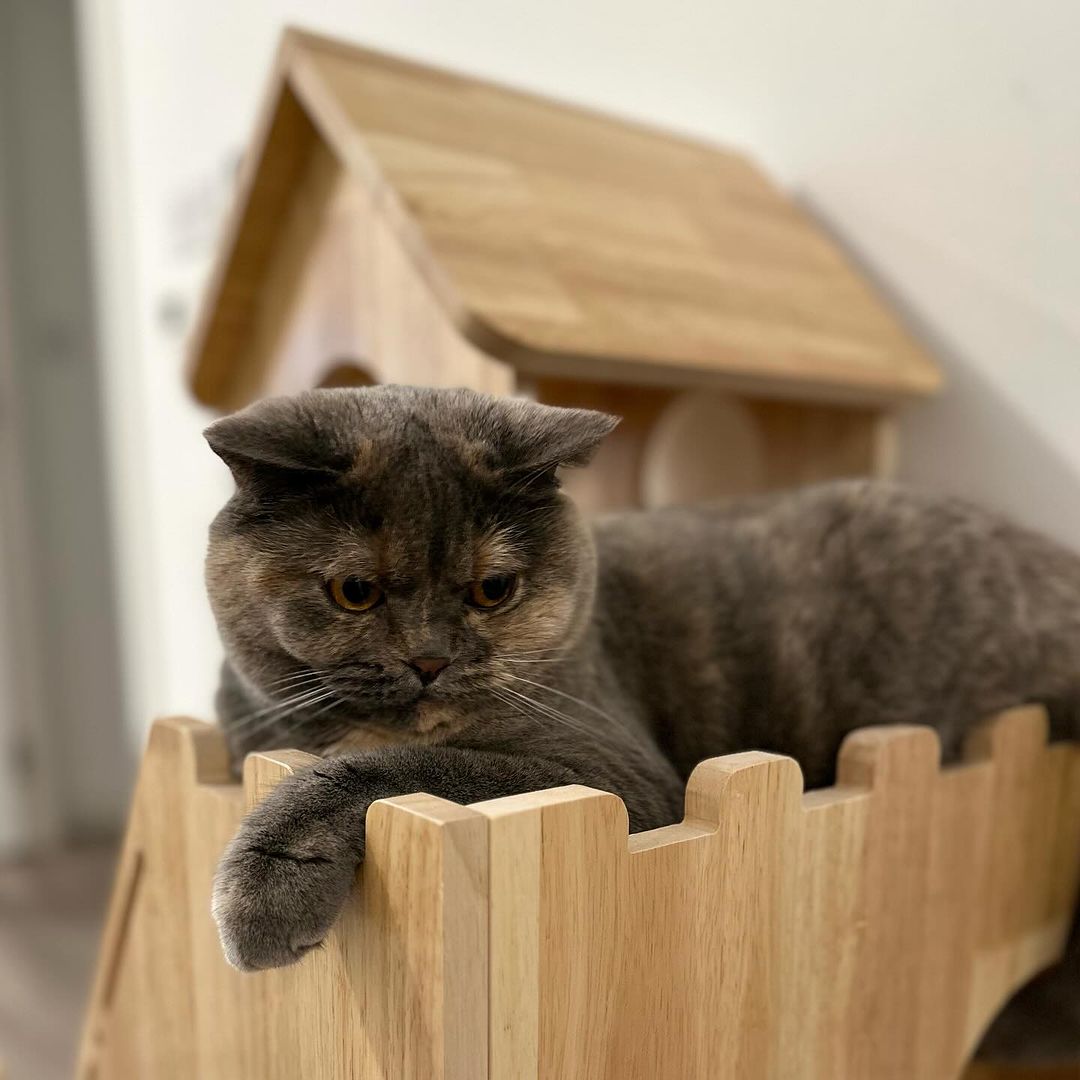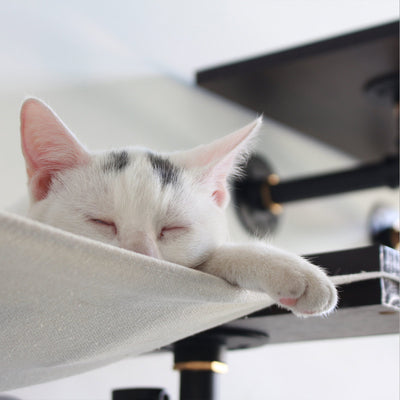Cat trees have become an increasingly popular cat furniture item in recent years, offering feline companions exercise, entertainment, and an alternative place to scratch instead of your furniture. The multiple platforms on cat trees give cats a place to play, relax, scratch, and observe their surroundings from different vantage points. Other benefits of cat trees include:
- Exercise and entertainment: Cat trees give cats an enriching outlet for their energy and predatory instincts to jump, climb, bat toys, and scratch.
- Reducing furniture damage: Having appropriate scratching surfaces helps redirect cats' scratching urges away from your furniture.
- Comfort and security: Cat trees with hideaways or cubby holes give cats a safe, cozy space of their own to retreat to.
With so many types, sizes, and designs of cat trees on the market, it can be tricky to select the perfect one for your feline companion. This guide will walk you through the key factors to consider so you can choose a cat tree that suits your cat's personality, abilities, and your home decor.
Cat Tree Basics: What to Look For
When evaluating different cat trees, there are some basic structural features to look for:
- Stable construction: The cat tree should have a sturdy, wobble-free base and be made of strong materials like wood.
- Adequate height: Cat trees should be tall enough for cats to get an enriched vantage point, usually at least 3-6 feet high.
- Multiple perches: Look for several platforms, perches, baskets and hammocks at varying heights for climbing and lounging.
- Scratching surfaces: Roomy scratching posts covered in sisal rope or carpet are ideal. Both vertical and horizontal scratching surfaces are great.
- Hideaways: Cubbies, condos and tunnels provide cozy spaces for cats to retreat to.
- Toys: Some cat trees incorporate toys like dangling feathers, crinkle balls and springs for extra enrichment.
Size and Space Considerations
The first step is assessing how much space you have available for a cat tree, and choosing a size that fits appropriately in your home.
- Take measurements of the floor area where you plan to place the cat tree. Make sure to leave enough open space around it so your cat can easily jump on and off.
- Think about ceiling height as well if considering taller cat trees.
- Make sure to leave open pathways in the room so the tree does not block walking paths.
- If you have multiple cats, opt for a larger cat tree with ample room for more than one cat.
- For kittens or senior cats with limited mobility, choose a smaller cat tree that is easy to access.
- For cats who like to climb and jump, select a taller cat tree with more levels.
Types and Features of Cat Trees
There are several styles and types of cat trees to choose from:
- Traditional cat trees: Freestanding floor cat trees with a wide base, scratching post "trunks", platforms and hideaways. These include mini, small, medium, large and extra-large sizes.
- Wall-mounted cat shelves or windows perches: Shelves that attach to the wall at different heights for cats to climb on and lounge. Great for small spaces.
- Scratching post integrated cat trees: Cat trees with multiple scratching posts as the main climbing features. Often covered in sisal rope or carpet.
- Multi-level and multifunctional cat trees: Elaborate cat trees with many platforms, tunnels, scratching surfaces and toys to create a cat playground.
Materials Matter: Durability and Safety
The materials used to construct and cover the cat tree impact its durability and safety:
- Sturdy base materials: Wood, especially solid wood rather than particleboard, is best for the cat tree base, platforms and posts. Metal frames are also durable options.
- Scratching post fabrics: The scratching surfaces should be covered in rough fabrics cats can grip like sisal rope, natural fiber carpet, or wood. Avoid fabrics like loop pile that can snag claws.
- Upholstery: For perches and hammocks, faux sheepskin or short plush fabrics make comfortable lounging surfaces. They should be removable for cleaning.
- Non-toxic: Ensure the cat tree is made of non-toxic materials.
Stability and Safety
It is not only the materials that matter, but also the stability. To keep your cat safe, the cat tree should be completely stable and secure.
- Stable base: Opt for a cat tree with a wide, heavy platform base that does not easily tip. Avoid lightweight cat trees.
- No wobbling: Cat trees should not shift or wobble at all when cats jump on and off or climb it.
- Secure attachments: All parts should be tightly screwed in or attached securely with steel bolts and wall anchors if needed.
- No head entrapment: Ensure there are no gaps where a cat could get their head stuck.
Cat Tree Placement
Choosing the right spot to place your cat tree is also important:
- Place the cat tree near a window so your cat can comfortably perch and watch outdoor activity.
- Avoid high traffic areas where your cat could get startled or disrupted often.
- Make sure the tree does not block pathways or furniture access.
- Use included hardware or wall anchors to securely attach the cat tree if it seems unstable or prone to tipping.
Think Like a Cat: Match Their Personality and Needs
At last, selecting a cat tree ultimately comes down to your individual cat's personality, abilities and needs:
- Kittens and energetic adult cats need taller cat trees with more challenging elements to climb and pounce on.
- Older or less agile cats prefer shorter trees with ramps or stairs for easy access.
- Timid cats like cat trees with fully enclosed condos or high vantage perches.
- Social cats will enjoy larger community cat trees if you have multiple cats.
- Prodigious scratchers need abundant scratching posts and surfaces.
- Horizontal scratchers prefer scratching platforms vs vertical posts.
Style and Design: Choosing What Speaks to You
While cats could care less about aesthetics, you will have to look at the cat tree every day, so pick something that aligns with your home décor:
- Traditional styles have wood bases and neutral color fabrics like beige or brown.
- Modern designs have sleek, contemporary lines and more colorful fabrics.
- Whimsical themes incorporate cute custom elements like leaves, flowers or animal shapes.
- Customization ideas: Add extra platforms, perches, tunnels or hammocks to make the cat tree your own.
Cat Tree Maintenance Tips
To extend the life of your cat tree, perform regular maintenance:
- Vacuum cat trees weekly to remove cat hair and dander buildup.
- Spot clean upholstery and covers as needed with mild soap and water.
- Replace sisal scratching surfaces once fraying or damage is visible.
- Check monthly that all parts are securely attached, screws are tightened, and structure is stable.
- Add catnip spray or treats to platforms to re-entice cats to use the tree.
Conclusion
Finding the ideal cat tree involves evaluating your cat's abilities, preferences, and your available space. Ensure the tree you choose is sturdy, safe, encourages activity, and provides cozy hideaways. Place it thoughtfully within your home decor. With this definitive guide, you can confidently select a cat tree that both you and your cat will love. Your feline will enjoy hours of enrichment and entertainment climbing, scratching, and lounging on their new tree!






